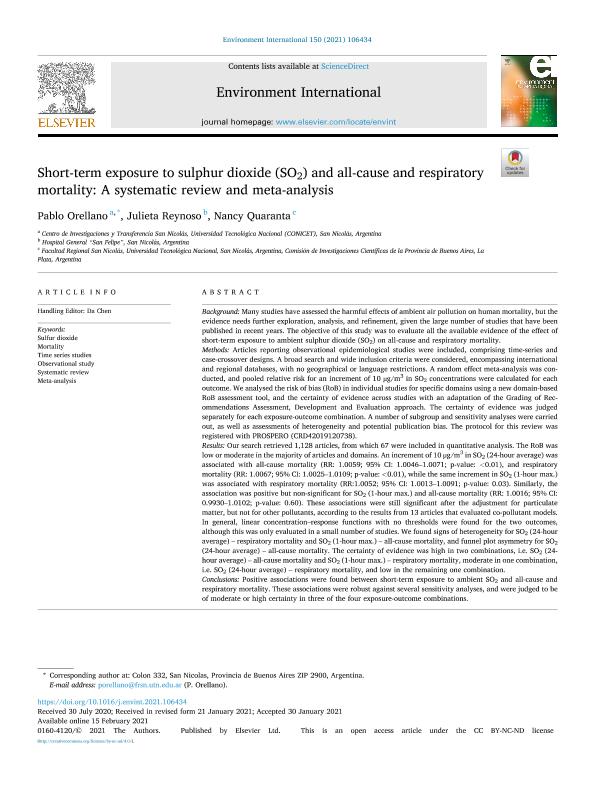Artículo
Short-term exposure to sulphur dioxide (SO2) and all-cause and respiratory mortality: A systematic review and meta-analysis
Fecha de publicación:
05/2021
Editorial:
Pergamon-Elsevier Science Ltd
Revista:
Environment International
ISSN:
0160-4120
Idioma:
Inglés
Tipo de recurso:
Artículo publicado
Clasificación temática:
Resumen
Background: Many studies have assessed the harmful effects of ambient air pollution on human mortality, but the evidence needs further exploration, analysis, and refinement, given the large number of studies that have been published in recent years. The objective of this study was to evaluate all the available evidence of the effect of short-term exposure to ambient sulphur dioxide (SO2) on all-cause and respiratory mortality. Methods: Articles reporting observational epidemiological studies were included, comprising time-series and case-crossover designs. A broad search and wide inclusion criteria were considered, encompassing international and regional databases, with no geographical or language restrictions. A random effect meta-analysis was conducted, and pooled relative risk for an increment of 10 µg/m3 in SO2 concentrations were calculated for each outcome. We analysed the risk of bias (RoB) in individual studies for specific domains using a new domain-based RoB assessment tool, and the certainty of evidence across studies with an adaptation of the Grading of Recommendations Assessment, Development and Evaluation approach. The certainty of evidence was judged separately for each exposure-outcome combination. A number of subgroup and sensitivity analyses were carried out, as well as assessments of heterogeneity and potential publication bias. The protocol for this review was registered with PROSPERO (CRD42019120738). Results: Our search retrieved 1,128 articles, from which 67 were included in quantitative analysis. The RoB was low or moderate in the majority of articles and domains. An increment of 10 µg/m3 in SO2 (24-hour average) was associated with all-cause mortality (RR: 1.0059; 95% CI: 1.0046–1.0071; p-value: <0.01), and respiratory mortality (RR: 1.0067; 95% CI: 1.0025–1.0109; p-value: <0.01), while the same increment in SO2 (1-hour max.) was associated with respiratory mortality (RR:1.0052; 95% CI: 1.0013–1.0091; p-value: 0.03). Similarly, the association was positive but non-significant for SO2 (1-hour max.) and all-cause mortality (RR: 1.0016; 95% CI: 0.9930–1.0102; p-value: 0.60). These associations were still significant after the adjustment for particulate matter, but not for other pollutants, according to the results from 13 articles that evaluated co-pollutant models. In general, linear concentration–response functions with no thresholds were found for the two outcomes, although this was only evaluated in a small number of studies. We found signs of heterogeneity for SO2 (24-hour average) – respiratory mortality and SO2 (1-hour max.) – all-cause mortality, and funnel plot asymmetry for SO2 (24-hour average) – all-cause mortality. The certainty of evidence was high in two combinations, i.e. SO2 (24-hour average) – all-cause mortality and SO2 (1-hour max.) – respiratory mortality, moderate in one combination, i.e. SO2 (24-hour average) – respiratory mortality, and low in the remaining one combination. Conclusions: Positive associations were found between short-term exposure to ambient SO2 and all-cause and respiratory mortality. These associations were robust against several sensitivity analyses, and were judged to be of moderate or high certainty in three of the four exposure-outcome combinations.
Archivos asociados
Licencia
Identificadores
Colecciones
Articulos(SEDE CENTRAL)
Articulos de SEDE CENTRAL
Articulos de SEDE CENTRAL
Citación
Orellano, Pablo Wenceslao; Reynoso, Julieta Itati; Quaranta, Nancy Esther; Short-term exposure to sulphur dioxide (SO2) and all-cause and respiratory mortality: A systematic review and meta-analysis; Pergamon-Elsevier Science Ltd; Environment International; 150; 5-2021; 1-14
Compartir
Altmétricas




